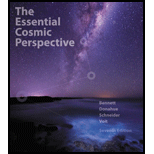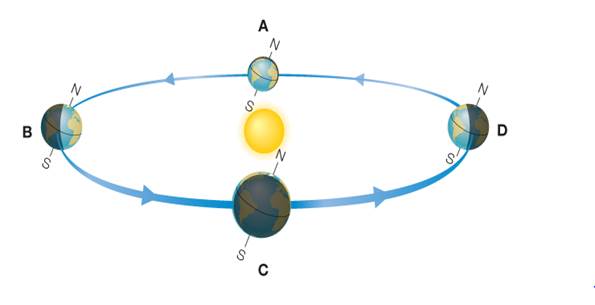
The Essential Cosmic Perspective (7th Edition) - Standalone book
7th Edition
ISBN: 9780321928085
Author: Jeffrey O Bennett, Megan O. Donahue, Nicholas Schneider, Mark Voit
Publisher: PEARSON
expand_more
expand_more
format_list_bulleted
Concept explainers
Textbook Question
Chapter 2, Problem 5VSC
Given that Earths actual distance from the Sun vanes by less than 3% over the course of a year, why does the diagram look so elliptical?
a. It correctly shows that Earth is closest to the Sun at points A and C and farthest at points B and D.
b. The elliptical shape is an effect of perspective, since the diagram shows an almost edge-on view of a nearly circular orbit.
c. The shape of the diagram is meaningless and is only for artistic effect.

Expert Solution & Answer
Want to see the full answer?
Check out a sample textbook solution
Students have asked these similar questions
3.37(a) Five free electrons exist in a three-dimensional infinite potential well with all three widths equal to \( a = 12 \, \text{Å} \). Determine the Fermi energy level at \( T = 0 \, \text{K} \). (b) Repeat part (a) for 13 electrons.
Book: Semiconductor Physics and Devices 4th ed, NeamanChapter-3Please expert answer only. don't give gpt-generated answers, & please clear the concept of quantum states for determining nx, ny, nz to determine E, as I don't have much idea about that topic.
3.37(a) Five free electrons exist in a three-dimensional infinite potential well with all three widths equal to \( a = 12 \, \text{Å} \). Determine the Fermi energy level at \( T = 0 \, \text{K} \). (b) Repeat part (a) for 13 electrons.
Book: Semiconductor Physics and Devices 4th ed, NeamanChapter-3Please expert answer only. don't give gpt-generated answers, & please clear the concept of quantum states for determining nx, ny, nz to determine E, as I don't have much idea about that topic.
No chatgpt pls will upvote
Chapter 2 Solutions
The Essential Cosmic Perspective (7th Edition) - Standalone book
Ch. 2 - Prob. 1VSCCh. 2 - Which of the four labeled points represents the...Ch. 2 - Which of the four labeled points represents the...Ch. 2 - The diagram exaggerates the sizes of Earth and the...Ch. 2 - Given that Earths actual distance from the Sun...Ch. 2 - As viewed from Earth, in which zodiac...Ch. 2 - If the date is April 21, what zodiac constellation...Ch. 2 - If the date is April 21, what zodiac constellation...Ch. 2 - Prob. 1EAPCh. 2 - Suppose you were making a model of the celestial...
Ch. 2 - On a clear, dark night, the sky may appear to be...Ch. 2 - Why does the local sky look like a dome? Define...Ch. 2 - Prob. 5EAPCh. 2 - What are circumpolar stars? Are more stars...Ch. 2 - What are latitude and longitude? Does the local...Ch. 2 - What is the zodiac, and why do we see different...Ch. 2 - Suppose Earth’s axis had no tilt. Would we still...Ch. 2 - Briefly describe key facts about the solstices and...Ch. 2 - What is precession? How does it affect our view of...Ch. 2 - Briefly describe the Moons cycle of phases. Can...Ch. 2 - Why do we always see the same face of the Moon?Ch. 2 - Why don’t we see an eclipse at every new and full...Ch. 2 - What do we mean by the apparent retrograde motion...Ch. 2 - Prob. 16EAPCh. 2 - Decide whether the statement makes sense (or is...Ch. 2 - Prob. 18EAPCh. 2 - Decide whether the statement makes sense (or is...Ch. 2 - Prob. 20EAPCh. 2 - Decide whether the statement makes sense (or is...Ch. 2 - Decide whether the statement makes sense (or is...Ch. 2 - Prob. 23EAPCh. 2 - Decide whether the statement makes sense (or is...Ch. 2 - Decide whether the statement makes sense (or is...Ch. 2 - Decide whether the statement makes sense (or is...Ch. 2 - Two stars that are in the same constellation (a)...Ch. 2 - The north celestial pole is 35° above your...Ch. 2 - Beijing and Philadelphia have about the same...Ch. 2 - In winter, Earth’s axis points toward the star...Ch. 2 - When it is summer in Australia, the season in the...Ch. 2 - If the Sun rises precisely due east. (a) you must...Ch. 2 - A week after full moon, the Moon’s phase is (a)...Ch. 2 - The fact that we always see the same face of the...Ch. 2 - If there is going to be a total lunar eclipse...Ch. 2 - When we see Saturn going through a period of...Ch. 2 - Prob. 37EAPCh. 2 - Prob. 38EAPCh. 2 - 39. Lunar Phases and Time of Day. Roles: Scribe...Ch. 2 - Prob. 40EAPCh. 2 - Your View of the Sky. a. What are your latitude...Ch. 2 - View from the Moon. Suppose you lived on the Moon,...Ch. 2 - View from the Sun. Suppose you lived on the Sun...Ch. 2 - Farther Moon. Suppose the distance to the Moon...Ch. 2 - Smaller Earth. Suppose Earth were smaller. Would...Ch. 2 - Prob. 46EAPCh. 2 - Prob. 47EAPCh. 2 - Find the Sun’s Diameter. The Sun has an angular...Ch. 2 - Prob. 49EAPCh. 2 - Prob. 50EAPCh. 2 - Prob. 51EAPCh. 2 - Flat Earth Society. Believe it or not, there is an...Ch. 2 - Prob. 53EAPCh. 2 - Prob. 54EAPCh. 2 - Prob. 55EAP
Knowledge Booster
Learn more about
Need a deep-dive on the concept behind this application? Look no further. Learn more about this topic, physics and related others by exploring similar questions and additional content below.Similar questions
- Use the following information to answer the next question. Two mirrors meet an angle, a, of 105°. A ray of light is incident upon mirror A at an angle, i, of 42°. The ray of light reflects off mirror B and then enters water, as shown below: Incident ray at A Note: This diagram is not to scale. a Air (n = 1.00) Water (n = 1.34) 1) Determine the angle of refraction of the ray of light in the water. Barrow_forwardHi can u please solvearrow_forward6. Bending a lens in OpticStudio or OSLO. In either package, create a BK7 singlet lens of 10 mm semi-diameter and with 10 mm thickness. Set the wavelength to the (default) 0.55 microns and a single on-axis field point at infinite object distance. Set the image distance to 200 mm. Make the first surface the stop insure that the lens is fully filled (that is, that the entrance beam has a radius of 10 mm). Use the lens-maker's equation to calculate initial glass curvatures assuming you want a symmetric, bi-convex lens with an effective focal length of 200 mm. Get this working and examine the RMS spot size using the "Text" tab of the Spot Diagram analysis tab (OpticStudio) or the Spd command of the text widnow (OSLO). You should find the lens is far from diffraction limited, with a spot size of more than 100 microns. Now let's optimize this lens. In OpticStudio, create a default merit function optimizing on spot size.Then insert one extra line at the top of the merit function. Assign the…arrow_forward
- No chatgpt pls will upvote Already got wrong chatgpt answer .arrow_forwardUse the following information to answer the next question. Two mirrors meet an angle, a, of 105°. A ray of light is incident upon mirror A at an angle, i, of 42°. The ray of light reflects off mirror B and then enters water, as shown below: A Incident ray at A Note: This diagram is not to scale. Air (n = 1.00) Water (n = 1.34) Barrow_forwardUse the following information to answer the next question. Two mirrors meet an angle, a, of 105°. A ray of light is incident upon mirror A at an angle, i, of 42°. The ray of light reflects off mirror B and then enters water, as shown below: A Incident ray at A Note: This diagram is not to scale. Air (n = 1.00) Water (n = 1.34) Barrow_forward
- Good explanation it sure experts solve it.arrow_forwardNo chatgpt pls will upvote Asaparrow_forwardA satellite has a mass of 100kg and is located at 2.00 x 10^6 m above the surface of the earth. a) What is the potential energy associated with the satellite at this loction? b) What is the magnitude of the gravitational force on the satellite?arrow_forward
- No chatgpt pls will upvotearrow_forwardCorrect answer No chatgpt pls will upvotearrow_forwardStatistical thermodynamics. The number of imaginary replicas of a system of N particlesa) cannot be greater than Avogadro's numberb) must always be greater than Avogadro's number.c) has no relation to Avogadro's number.arrow_forward
arrow_back_ios
SEE MORE QUESTIONS
arrow_forward_ios
Recommended textbooks for you
 Physics for Scientists and Engineers: Foundations...PhysicsISBN:9781133939146Author:Katz, Debora M.Publisher:Cengage Learning
Physics for Scientists and Engineers: Foundations...PhysicsISBN:9781133939146Author:Katz, Debora M.Publisher:Cengage Learning Horizons: Exploring the Universe (MindTap Course ...PhysicsISBN:9781305960961Author:Michael A. Seeds, Dana BackmanPublisher:Cengage Learning
Horizons: Exploring the Universe (MindTap Course ...PhysicsISBN:9781305960961Author:Michael A. Seeds, Dana BackmanPublisher:Cengage Learning AstronomyPhysicsISBN:9781938168284Author:Andrew Fraknoi; David Morrison; Sidney C. WolffPublisher:OpenStax
AstronomyPhysicsISBN:9781938168284Author:Andrew Fraknoi; David Morrison; Sidney C. WolffPublisher:OpenStax An Introduction to Physical SciencePhysicsISBN:9781305079137Author:James Shipman, Jerry D. Wilson, Charles A. Higgins, Omar TorresPublisher:Cengage Learning
An Introduction to Physical SciencePhysicsISBN:9781305079137Author:James Shipman, Jerry D. Wilson, Charles A. Higgins, Omar TorresPublisher:Cengage Learning Glencoe Physics: Principles and Problems, Student...PhysicsISBN:9780078807213Author:Paul W. ZitzewitzPublisher:Glencoe/McGraw-Hill
Glencoe Physics: Principles and Problems, Student...PhysicsISBN:9780078807213Author:Paul W. ZitzewitzPublisher:Glencoe/McGraw-Hill Foundations of Astronomy (MindTap Course List)PhysicsISBN:9781337399920Author:Michael A. Seeds, Dana BackmanPublisher:Cengage Learning
Foundations of Astronomy (MindTap Course List)PhysicsISBN:9781337399920Author:Michael A. Seeds, Dana BackmanPublisher:Cengage Learning

Physics for Scientists and Engineers: Foundations...
Physics
ISBN:9781133939146
Author:Katz, Debora M.
Publisher:Cengage Learning

Horizons: Exploring the Universe (MindTap Course ...
Physics
ISBN:9781305960961
Author:Michael A. Seeds, Dana Backman
Publisher:Cengage Learning

Astronomy
Physics
ISBN:9781938168284
Author:Andrew Fraknoi; David Morrison; Sidney C. Wolff
Publisher:OpenStax

An Introduction to Physical Science
Physics
ISBN:9781305079137
Author:James Shipman, Jerry D. Wilson, Charles A. Higgins, Omar Torres
Publisher:Cengage Learning

Glencoe Physics: Principles and Problems, Student...
Physics
ISBN:9780078807213
Author:Paul W. Zitzewitz
Publisher:Glencoe/McGraw-Hill

Foundations of Astronomy (MindTap Course List)
Physics
ISBN:9781337399920
Author:Michael A. Seeds, Dana Backman
Publisher:Cengage Learning
General Relativity: The Curvature of Spacetime; Author: Professor Dave Explains;https://www.youtube.com/watch?v=R7V3koyL7Mc;License: Standard YouTube License, CC-BY